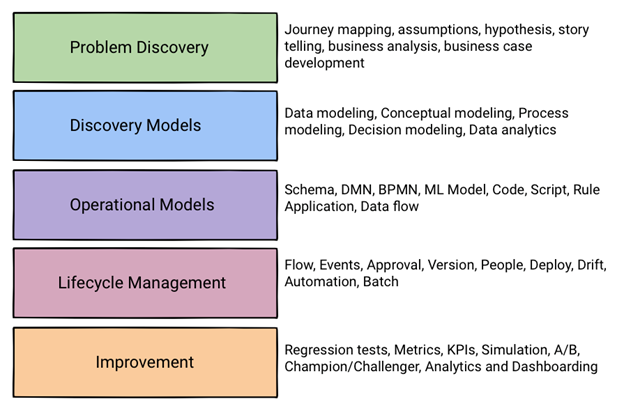Last year, I spoke at Decision Camp about practices that rapidly orient a new team and get them discovering problems in their project–like a compass orienting them toward the North Star. We covered exploring a journey, working through assumptions, stating the problem and telling the story of our future goal. These essential practices accelerate project delivery. We worry when teams jump too quickly into operational concerns because they will deliver less impact for the same investment.
But today, I want to spotlight the next peril. There is a cliff waiting for projects after the go-live celebration. Now the organization must live with the solution. Living with decision automation requires the same rigor and careful execution as the initial phases of the project. What’s in the backlog after go-live? We find a list of important deferred features, bugs, and technical debt. Many tasks remain manual and while the finish line approaches, little time was expended toward automating the lifecycle or tracking data for business impact.
Long-term success requires a broad view of the investment across teams and activities making sure the effort doesn’t drift, get mired in manual activities, and most importantly finish the work required to confirm the business case and make adjustments. The key areas of an automation project are broken down into five areas:

1. Problem Discovery
In the early days of a project, discovery dominates activities. Teams should be engaged in defining why they are working on this project, its scope and what business impact will be delivered. This critical effort orients the team and establishes what improvement will be measured later:
- What general framing do we have for this project?
- What assumptions do we have about this effort?
- What does the journey look like with our must-have problems to solve?
- Our problem statement.
- Our goal statement.
- Any narratives the team wishes to share that bring home the emotional impact if they succeed.
2. Discovery Models
Modeling for the purpose of discovery provide the next level of storytelling with tangible assets. These assets are not intended to be complete but rather explain in more detail what needs to happen. For example, these models help us understand the following:
- What data do we need? What does it look like and how does it relate to other data?
- Do we need a data vendor or partnership?
- What do the operational data models/schemas require? Do we have examples?
- What does the current process look like? What should the new process look like operationally?
- What decisions do we need?
- Do any of these decisions require ML models?
- Do we require data flows for transformation, abstraction, and integration?
3. Operational Models
Everyone wants to get to work. Operational models deliver working automation with the intent of going into production.
- Process models broken down into the right parts.
- Decisions that drive value across channels.
- ML Models that predict and detect.
- Data models and schema that glue the solution together.
- Data flows that remove gaps and push data where you need it.
4. Lifecycle Management
The basic lifecycle usually establishes itself during the operational phases of a project, however, automation of the lifecycle is “DevOps” pure and simple. This also includes “Ops” for ML models, data flows, processes and decisions. This really is the glue that makes everything transparent and predictable:
- DevOps for decisions, ML models, processes, and data flows.
- Approvals for promotion.
- Notifications and push of reports – portable lifecycle artifacts like diff reports after making a change.
- Triggers to other platforms that do builds of software assets (Azure DevOps) and interact with code repositories like Github.
- Batch processing for training and running production automation.
5. Improvement
Every piece of automation produces metric-level data useful for dashboards and tracking KPIs. This work is essential in proving the business case and providing data-driven insights into future hypotheses and digital transformation:
- Turn on metrics and push data for analytics.
- Complete the work to auto-train ML models by detecting drift.
- Create and push dashboards to stakeholders tracking results.
- Establish types of testing (A/B, etc)
So what makes automation sustainable? It’s making the investment beyond go-live and making sure the automation has both business impact and that the required operational efficiencies are implemented. While you are in the early phases of your project, that’s the best time to work with us and start asking more questions like, “What are we missing?”


